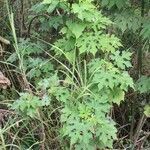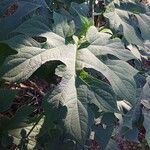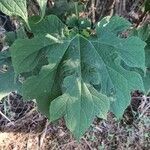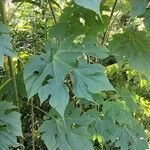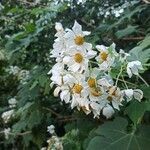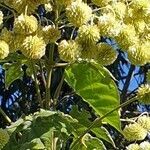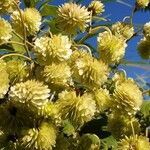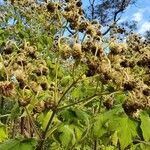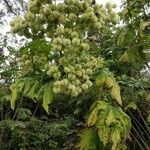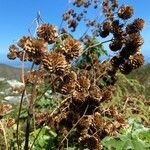Large shrubs, erect, soft-wooded, (1.5–) 3–4 m high. Leaves: petiole 4–8 (–12) cm long, ±stem-clasping, lacking stipule-like lobes at base; lamina ovate to pentagonal in outline, usually deeply palmately 3–5 (–7)-lobed, (7–) 20–40 cm long, (2.5–) 20–30 cm wide, often with prominent auricles at base, long-acuminate (rarely acute), discolorous, with adaxial surface moderately pubescent and abaxial surface moderately to densely glandular and pubescent; lobes ovate to deltoid or cordate. Capitula pendulous, several in compound mainly oppositely branched corymbs; peduncles 2–6 cm long, densely hairy; involucral bracts ±uniseriate, reflexed in fruit, pilose; paleae obtrullate, 2.5 mm long, with long acuminate apex 1–2 mm long, pilose, accrescent and shed with achenes. Ray florets 7 or 8; ligules 15–25 mm long. Disc florets 85–105, c. 2 mm long, moderately to densely pubescent, yellow. Achenes c. 3 mm long. 1.5 mm wide.
Shrub or woody herb 1–6 m high; branches pubescent to glabrous.. Leaves ovate to pentagonal, 7–40 cm long, 2.5–30 cm wide, entire or 3–5-lobed, the lobes themselves with secondary lobes, margins crenate to serrate, apices attenuate, pubescent to scabridulous on both surfaces and glandular beneath; petiole 1–8 cm long, often with auricles at apex.. Capitula in corymbose panicles, pendulous; stalks of individual capitula 2–6 cm long; involucre 1-seriate; phyllaries 4–5 mm long, reflexed in fruit; paleae 3–3.5 mm long, to 10 mm long in fruit.. Ray florets 7–8, ray white, 15–17 mm long, tube yellow, < 1 mm long; disc florets many, yellow, 1–1.2 mm long.. Achenes brown or red-brown, 3–3.5 mm long, rugulose, the apex glandular; pappus absent.. Fig. 160 (page 756).
Shrub or woody herb 1-6 m high; branches pubescent to glabrous. Leaves ovate to pentagonal, 7-40 cm long, 2.5-30 cm wide, entire or 3-5-lobed, the lobes themselves with secondary lobes, margins crenate to serrate, apices attenuate, pubescent to scabridulous on both surfaces and glandular beneath; petiole 1-8 cm long, often with auricles at apex. Capitula in corymbose panicles, pendulous; stalks of individual capitula 2-6 cm long; involucre 1-seriate; phyllaries 4-5 mm long, reflexed in fruit; paleae 3.0-3.5 mm long, to 10 mm long in fruit. Ray florets 7-8, ray white, 15-17 mm long, tube yellow, < 1 mm long; disc florets many, yellow, 1.0-1.2 mm long. Achenes brown or red-brown, 3.0-3.5 mm long, rugulose, the apex glandular; pappus absent.
Perennial subshrub up to 6 m high; scarcely branched. Leaves opposite, broadly ovate in outline, palmately lobed, softly pubescent, base deeply cordate with pair of auricles at apex of petiole, apex acuminate. Capitula radiate, many in terminal, corymbose panicles; involucral bracts lanceolate-acuminate, pubescent. Ray florets neuter; corolla strap-shaped, white. Disc florets bisexual, fertile; corolla yellow, tubular below, campanulate above, 5-lobed. Anthers obtuse at base, apical appendage narrowly deltoid. Style branches oblong, apices deltoid, papillae present on outside. Pappus absent. Cypselae narrowly obovate, 4-angled, apically with ring-shaped collar.
Semishrub, up to 6 m high. Leaves opposite, deeply palmately lobed, softly pubescent, base deeply cordate with a pair of auricles at apex of petiole, petiole up to 100 mm. Flowers with white rays and yellow disc.
